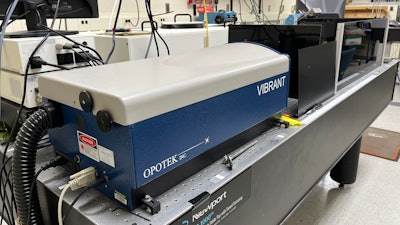
In physical chemistry, time-resolved spectroscopy is the study of dynamic processes in materials or chemical compounds. Within this field, various techniques including transient absorption spectroscopy are used to study the mechanistic and kinetic details of chemical processes that occur within just a few picoseconds to a femtosecond – the equivalent of one millionth of one billionth of a second.
To conduct this research, labs require fast lasers that can create an excited electronic state of a molecule on this time scale. Since all molecules do not absorb the same wavelengths of light, these lasers must be flexible enough to produce wavelengths across a broad spectrum. In the past, it was difficult, if not impossible to conduct spectroscopic research using inexpensive, fixed wavelength lasers. This was extremely inefficient when conducting fundamental research at the academic level on a wide variety of metal-based complexes.
As a result, many research labs are turning to tunable lasers, or Optical Parametric Oscillators (OPOs), for nanosecond time-resolved spectroscopy. OPOs have long been utilized in sophisticated test and measurement applications such as mass spectrometry and photoacoustic imaging. Now, these “tunable” pulsed lasers are being utilized due to the high resolution and variety of nanosecond wavelength pulses they can produce from visible light to deep UV.
“You don’t want to have to design your chemistry such that it is tailored just to the particular wavelengths you have available in your instrumentation. You want the lasers to be flexible enough to adapt to the chemistry you want to explore,” said Dr. James McCusker, an MSU Foundation Professor in the Department of Chemistry at Michigan State University who leads a research group of PhD students in the study of cutting edge techniques in spectroscopy. His group conducts fundamental research on designing and synthesizing molecules to absorb in the visible part of the spectrum.
“We only want to be limited by our imaginations, not by what wavelengths we can get out of a particular laser,” added Dr. McCusker, who has worked in the field for nearly 30 years.
Ultrafast spectroscopy of transition metals
In the case of Dr. McCusker’s research, his team of PhD students study a class of compounds known as transition metal complexes. These compounds are based on elements from the so-called transition block of the perodic table. The focus of the group’s research is to understand how a molecule’s structure, composition and absorptive properties relate to their ability to carry out light-induced chemical reactions.
According to Dr. McCusker, one of the primary areas of research relates to solar energy conversion. Transition metal complexes are an important class of molecules in this field of research and can be studied using time-resolved spectroscopy to examine the thermodynamics and conversion efficiencies of solar cells, the potential use of alternative and less expensive earth-abundant materials for processes that can achieve light-to-chemical energy conversion and for designing molecules whose excited-state properties will enable their use in a wide range of such compounds to enable new kinds of organic transformations of potential interest in the pharmaceutical industry.
“We are pursuing a systematic examination of chemical perturbations to excited-state electronic and geometric structure,” said Dr. McCusker. “As a result, we will be able to develop a comprehensive picture of how transition metal chromosphores absorb and dissipate energy.”
Getting on the right wavelength
To facilitate this type of research, fast, pulsed lasers are required to selectively excite a molecule to a specific state to study the compound’s excited-state properties. In the early days of laser development, lasers were constructed to operate at very specific wavelengths. Single wavelength Nd:YAG lasers, for example, are inexpensive and simple to use. However, additional hardware is required to modify a 1064-nm laser before it can operate at a different harmonic frequency for testing such as 213, 266, 355 and 532 nm. This adds to the cost of the laser.
“There are gaps between the wavelengths, and the jump between 1064 nm to 532 nm is significant,” said Dr. Mark Little, Technical and Scientific Consultant for OPOTEK, adding that testing each of those harmonics increases the cost. The Carlsbad, California-based OPOTEK offers solutions for specialized applications including photoacoustic, spectroscopy, diagnostics, hyperspectral imaging and medical research.
According to Little, OPO lasers can convert the fundamental wavelength of pulsed mode Nd:YAGs to a selected frequency
This tunability enables OPOs to generate light in a broad range of wavelengths that are amplified within the OPO for a usable output beam.
“An OPO laser can be tuned to a very specific wavelength resolution by simply punching in a number like 410, 410.1 or 410.2 nanometers,” explained Dr. Little.
These pulse-based OPO lasers can deliver concentrated energy in short durations measured in nanoseconds making them ideal for nanosecond time resolved spectroscopy.
Dr. McCusker and his research group use the Vibrant 355 II Nd:YAG-pumped OPO laser from OPOTEK which can quickly provide a tunable wavelength output from 300-2400 nm and is used for both time-resolved absorption and time-resolved emission requirements.
OPOTEK began operations supporting the academic community and over the years have developed a robust connection with industry heavyweights. In Dr. McCusker’s case, he has relied exclusively on their OPO lasers for the portion of his research program focused on nanosecond time-resolved spectroscopy since 1995 when he was an assistant professor at UC Berkeley.
“Now I’ve got access to an enormous range of excitation wavelengths from the same instrument,” said Dr. McCusker. “The instrumentation has become a flexible tool so our chemistry can be whatever it needs to be.”
Today OPOTEK lasers include software applications which have made them more user-friendly. Added Dr. McCusker, “with the evolution of their lasers over time, it has become easier to train students how to use the equipment.”
Reaching into Deep UV
Much of the research conducted by Dr. McCusker and his team, such as solar energy conversion studies, involves designing and synthesizing molecules that absorb light in the visible part of the spectrum.
However, he notes that for organic carbon-based or aromatic compounds, researchers may want to study UV damage to DNA. Since DNA is composed of organic base pairs that absorb in the ultraviolet spectrum rather than the visible spectrum, OPO lasers are required to access those ultraviolet wavelengths for the study of these compounds.
Leading manufacturers like OPOTEK have developed a diverse array of OPO technologies that ensures wavelengths from the mid-infrared to deep UV can easily be produced. OPO lasers can be designed to generate wavelengths down to 190 nanometers through multiple stages of optical conversion, according to Dr. Little. Moreover, unlike typical fixed wavelength deep ultraviolet (UV) lasers, OPO lasers are solid-state and so do not require expensive consumables such as specialized gas or chemical mixtures as the lasing medium.
Future time-resolved spectroscopic research by academic research labs will continue to rely on the flexibility and tunability of OPO lasers to further their knowledge of how materials transmit, absorb and reflect light. Sectors such as solar energy conversion will be among the many beneficiaries of spectroscopic research that can explore more of the spectrum of possibilities through cutting edge techniques facilitated by OPO lasers.























